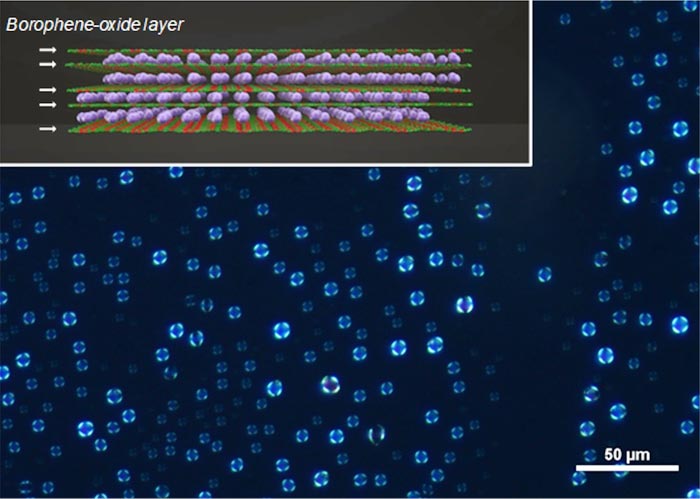Inorganic borophene liquid crystals …

The inset shows a chemical structure of the prepared BoLs. White arrows indicate the borophene oxide atomic layers and purple spheres represent potassium cations.
Credit: Tetsuya Kambe from Tokyo Institute of Technology
A superior new material for optoelectronic devices.
Liquid crystals derived from borophene have risen in popularity, owing to their immense applicability in optoelectronic and photonic devices. However, their development requires a very narrow temperature range, which hinders their large-scale application. Now, Tokyo Tech researchers investigated a liquid-state borophene oxide, discovering that it exhibited high thermal stability and optical switching behavior even at low voltages. These findings highlight the strong potential of borophene oxide-derived liquid crystals for use in widespread applications.
Two-dimensional (2D) atomic layered materials, such as the carbon-based graphene and the boron-based borophene, are highly sought after for their applications in a variety of optoelectronic devices, owing to their desirable electronic properties. The monolayer structure of borophene with a network of boron bonds endows it with high flexibility, which can be beneficial for the generation of a liquid state at low temperatures. Thus, it is not surprising that liquid crystals derived from 2D networked structures are in high demand. However, the poor stability of borophene, in particular, makes it difficult for it to undergo a phase transition to the liquid state.
In contrast, borophene oxide—a derivative of borophene—can improve the stability of the internal boron network, in turn stabilizing the entire structure. This property of borophene oxide is different from that of other 2D materials, which are unable to yield liquid crystals without the use of solvents.
To compensate for the lack of suitable liquid crystals, a team of researchers from Japan, including Assistant Professor Tetsuya Kambe and Professor Kimihisa Yamamoto from Tokyo Institute of Technology, investigated the properties of a borophene oxide analogue as a fully inorganic liquid with a layered structure. Their study was recently published in Nature Communications.
Initially, the team used previously tested methods to generate borophene oxide layers (BoL) as crystals (BoL-C). They then converted BoL-C to liquid crystals (BoL-LC) by heating them to temperatures of 105-200°C. They observed that the resultant dehydration weakened the interactions between the interlayers of BoL-C, which is desirable for its flexibility.
The team then analyzed the structural properties of BoL-LC using polarized optical microscopy, discovering that BoL-LC sheets are found stacked parallel to the surface of the liquid drop with a slightly curved form. This spherulite orientation of borophene sheets was confirmed using scanning electron microscopy.
An analysis of the phase transition features revealed that phase transition (P-ii/P-i) occurred at around 100°C for BoL-LC. In fact, both transition phases exhibited high thermal stability at extreme temperatures. The team also observed a highly ordered orientation of the P-ii phase.
To test its optical switching behavior, the team created a dynamic scattering device using BoL-LC, and found that unlike other organic liquid crystals, the BoL-based device responded well to voltages as low as 1V. These findings highlight the feasibility of inorganic liquid devices in harsh environments.
“Although a liquid crystal device using graphene oxide has been reported previously, it was a lyotropic liquid crystal, with a strong dependence on the solution concentration. Therefore, the previously reported material is different from the liquid borophene created in this study, without the use of any solvents,” says Dr. Kambe, while discussing the advantages of BoL-LC over other 2D liquid crystals.
What’s more, they found that even upon exposure to direct fire, BoL-LC was noncombustible! This confirms that BoL-LC in a liquid state with an ordered layer structure can exist over a wide range of temperatures – a property which has not been observed so far for other organic materials.
When asked about the implications of these findings, Dr. Kambe and Dr. Yamamoto stated, “BoL-LC exhibits strong potential for use in widespread applications, that are unavailable to conventional organic liquid crystals or inorganic materials.”
Indeed, borophene liquid crystals are stacked with several advantages and may expedite important developments in the optoelectronics and photonics industry in the future!
About Tokyo Institute of Technology
Tokyo Tech stands at the forefront of research and higher education as the leading university for science and technology in Japan. Tokyo Tech researchers excel in fields ranging from materials science to biology, computer science, and physics. Founded in 1881, Tokyo Tech hosts over 10,000 undergraduate and graduate students per year, who develop into scientific leaders and some of the most sought-after engineers in industry. Embodying the Japanese philosophy of “monotsukuri,” meaning “technical ingenuity and innovation,” the Tokyo Tech community strives to contribute to society through high-impact research.
https://www.titech.ac.jp/english/
Journal: Nature Communications DOI: 10.1038/s41467-022-28625-w Method of Research: Experimental study Subject of Research: Not applicable Article Title: Liquid crystalline 2D borophene oxide for inorganic optical devices Article Publication Date: 24-Feb-2022
Media Contact
Emiko Kawaguchi
Tokyo Institute of Technology
kawaguchi.e.aa@m.titech.ac.jp
Office: 3-57342975
Original Source
All latest news from the category: Materials Sciences
Materials management deals with the research, development, manufacturing and processing of raw and industrial materials. Key aspects here are biological and medical issues, which play an increasingly important role in this field.
innovations-report offers in-depth articles related to the development and application of materials and the structure and properties of new materials.
Newest articles

Silicon Carbide Innovation Alliance to drive industrial-scale semiconductor work
Known for its ability to withstand extreme environments and high voltages, silicon carbide (SiC) is a semiconducting material made up of silicon and carbon atoms arranged into crystals that is…

New SPECT/CT technique shows impressive biomarker identification
…offers increased access for prostate cancer patients. A novel SPECT/CT acquisition method can accurately detect radiopharmaceutical biodistribution in a convenient manner for prostate cancer patients, opening the door for more…

How 3D printers can give robots a soft touch
Soft skin coverings and touch sensors have emerged as a promising feature for robots that are both safer and more intuitive for human interaction, but they are expensive and difficult…





















